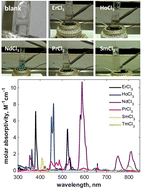Absorption spectroscopy for the quantitative prediction of lanthanide concentrations in the 3LiCl–2CsCl eutectic at 723 K†
Abstract
The absorption spectra of single-component mixtures of erbium(III) chloride, holmium(III) chloride, neodymium(III) chloride, praseodymium(III) chloride, samarium(III) chloride and thulium(III) chloride were obtained in the molten salt eutectic 3LiCl–2CsCl at 723 K and were collected at various concentrations from 0 mM to approximately 200 mM (above which the solutions became saturated). Using these data and Beer's law, the molar absorptivities of the absorption bands for each lanthanide(III) chloride were obtained. More sophisticated analysis of the data was completed by building multivariate regression models based on spectra of single-component samples for each lanthanide metal studied. These models were then applied to the measurement/prediction of lanthanide(III) concentrations in a validation set comprised of complex multi-component mixtures within the molten-salt solution. The models performed well despite the complexity of the solutions/spectra. Overall, this work presents the UV-vis Beer's law characterization of several lanthanides as well as successful application of multivariate analysis to the measurement/prediction of lanthanide concentrations in molten salts. This represents a significant improvement for materials analysis techniques, applicable for nuclear fuel pyroprocessing methods.

- This article is part of the themed collection: In memory of Craig Lunte

 Please wait while we load your content...
Please wait while we load your content...